Time-dependent improvement in functional outcome following LCS rotating platform knee replacement
- PMID: 21067429
- PMCID: PMC3216084
- DOI: 10.3109/17453674.2010.533929
Time-dependent improvement in functional outcome following LCS rotating platform knee replacement
Abstract
Background and purpose: Long-term follow-up studies after total knee replacement (TKR) using an LCS rotating platform have shown survival rates of up to 97%. Few studies have evaluated short-term functional outcome and its improvement over time. We determined the time course of functional outcome as evaluated by the knee injury and osteoarthritis outcome score (KOOS) over the first 4 years after TKR using the LCS mobile bearing.
Patients and methods: 50 unselected patients (mean age 70 (40-85) years, 33 women) with osteoarthritis in one knee underwent TKR with an LCS mobile bearing. Data were collected by an independent investigator preoperatively and at 6 weeks, 3 months, 6 months, 1 year, 2 years and 4 years postoperatively. KOOS, a self-assessment function score validated for this purpose, and range of motion (ROM) were determined at all follow-ups.
Results: The mean KOOS pain score increased from 43 before surgery to 66 at 6 weeks and 88 at 2 years. It was 84 at 4 years. The mean KOOS activities of daily living score (ADL) increased from 49 before surgery to 73 at 6 weeks, then gradually to 90 at 2 years. It decreased to 79 at 4 years. Mean passive ROM was 112° before surgery, 78° at departure from hospital, and then gradually increased to 116° at 2 years and 113° at 4 years.
Interpretation: Recovery after TKR is time-dependent. Most of the expected improvement in pain and function is achieved at 6 months postoperatively, but some further improvement can be expected up to 2 years postoperatively. ROM will also gradually improve up to 2 years after TKR, and reach the same level as before surgery.
Figures
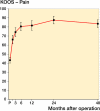
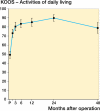
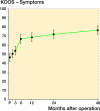
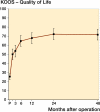
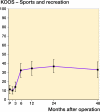
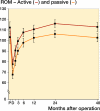
Similar articles
-
LCS mobile-bearing total knee replacement. A 10-year's follow-up study.Orthop Traumatol Surg Res. 2009 May;95(3):177-82. doi: 10.1016/j.otsr.2009.02.002. Epub 2009 Mar 27. Orthop Traumatol Surg Res. 2009. PMID: 19328763
-
The outcome of rotating-platform total knee arthroplasty with cement at a minimum of ten years of follow-up.J Bone Joint Surg Am. 2012 Apr 4;94(7):638-44. doi: 10.2106/JBJS.K.00263. J Bone Joint Surg Am. 2012. PMID: 22488620
-
Time-dependent improvement in functional outcome following Oxford medial unicompartmental knee arthroplasty. A prospective longitudinal multicenter study involving 96 patients.Acta Orthop. 2012 Feb;83(1):46-52. doi: 10.3109/17453674.2011.652890. Epub 2012 Jan 17. Acta Orthop. 2012. PMID: 22248171 Free PMC article.
-
Short-term functional versus patient-reported outcome of the bicruciate stabilized total knee arthroplasty: prospective consecutive case series.BMC Musculoskelet Disord. 2014 Dec 16;15:435. doi: 10.1186/1471-2474-15-435. BMC Musculoskelet Disord. 2014. PMID: 25515192 Free PMC article.
-
What's important for recovery after a total knee replacement? A systematic review of mixed methods studies.Arch Orthop Trauma Surg. 2024 May;144(5):2213-2221. doi: 10.1007/s00402-023-05136-x. Epub 2023 Dec 9. Arch Orthop Trauma Surg. 2024. PMID: 38070014 Free PMC article.
Cited by
-
Associations between early postoperative pain outcome measures and late functional outcomes in patients after knee arthroplasty.PLoS One. 2021 Jul 28;16(7):e0253147. doi: 10.1371/journal.pone.0253147. eCollection 2021. PLoS One. 2021. PMID: 34320012 Free PMC article.
-
Expectation fulfillment is associated with good outcomes and patient satisfaction after knee arthroplasty: a prospective study in a multi-ethnic Asian population.Sci Rep. 2025 Apr 30;15(1):15133. doi: 10.1038/s41598-025-91492-0. Sci Rep. 2025. PMID: 40307268 Free PMC article.
-
Device-Measured Physical Activity in 3506 Individuals with Knee or Hip Arthroplasty.Med Sci Sports Exerc. 2024 May 1;56(5):805-812. doi: 10.1249/MSS.0000000000003365. Epub 2023 Dec 18. Med Sci Sports Exerc. 2024. PMID: 38109175 Free PMC article.
-
Does Discharge Destination Matter after Total Knee Arthroplasty? A Single-Institution Korean Experience.Knee Surg Relat Res. 2018 Sep 1;30(3):215-226. doi: 10.5792/ksrr.17.060. Knee Surg Relat Res. 2018. PMID: 30157589 Free PMC article.
-
Does cruciate retention primary total knee arthroplasty affect proprioception, strength and clinical outcome?Knee Surg Sports Traumatol Arthrosc. 2015 Jun;23(6):1644-52. doi: 10.1007/s00167-014-3384-8. Epub 2014 Oct 25. Knee Surg Sports Traumatol Arthrosc. 2015. PMID: 25343873
References
-
- Buechel FF. Long-term followup after mobile-bearing total knee replacement. Clin Orthop. 2002;((404)):40–50. - PubMed
-
- Callaghan JJ, O'Rourke MR, Iossi MF, Liu SS, Goetz DD, Vittetoe DA, et al. Cemented rotating-platform total knee replacement. A concise follow-up, at a minimum of fifteen years, of a previous report. J Bone Joint Surg (Am) 2005;87((9)):1995–8. - PubMed
-
- Dennis DA, Komistek RD, Scuderi GR, Zingde S. Factors affecting flexion after total knee arthroplasty. Clin Orthop. 2007;((464)):53–60. - PubMed
-
- Fitzgerald JD, Orav EJ, Lee TH, Marcantonio ER, Poss R, Goldman L, Mangione CM. Patient quality of life during the 12 months following joint replacement surgery. Arthritis Rheum. 2004;51((1)):100–9. - PubMed
-
- Garratt AM, Brealey S, Gillespie WJ. Patient-assessed health instruments for the knee: a structured review. Rheumatology. 2004;43((11)):1414–23. - PubMed
MeSH terms
Substances
LinkOut - more resources
Full Text Sources
Medical
